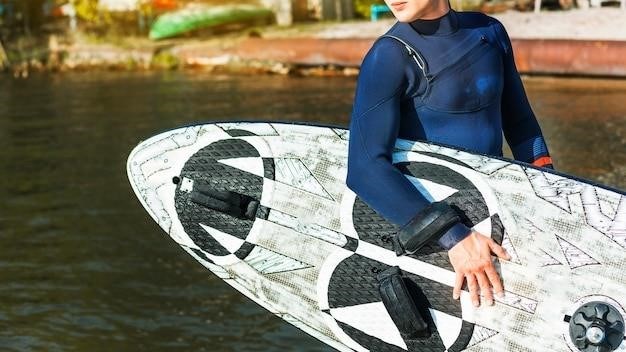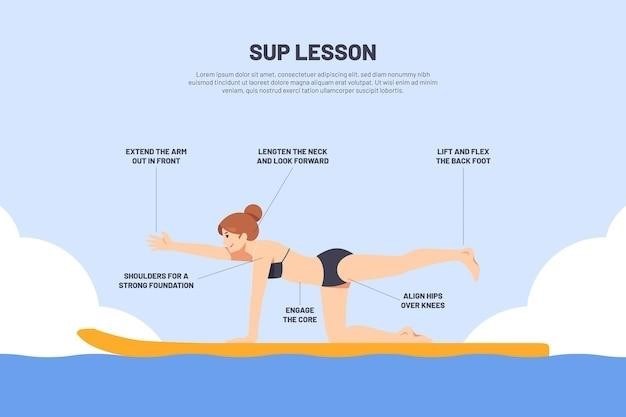Kayak Size Guide⁚ Finding the Perfect Fit
Choosing the right kayak involves considering several factors for optimal performance and comfort․ Kayak length‚ width‚ volume‚ and cockpit size all impact stability‚ speed‚ and maneuverability․ This guide helps determine the perfect kayak based on your height‚ weight‚ experience‚ and intended use‚ ensuring a safe and enjoyable paddling experience․
Understanding Kayak Types and Their Sizes
Kayaks come in various types‚ each designed for specific paddling styles and conditions․ Recreational kayaks‚ typically 8-12 feet long‚ offer excellent stability for leisurely paddling on calm waters․ They are ideal for beginners and those prioritizing comfort over speed․ Touring kayaks‚ ranging from 12-16 feet‚ provide increased speed and tracking for longer distances‚ making them suitable for exploring lakes and rivers․ Sea kayaks‚ generally 16-17 feet or longer‚ are designed for open-water conditions‚ emphasizing efficiency and stability in challenging environments․ Their length enhances tracking‚ while their design promotes stability in waves and currents․ Whitewater kayaks‚ significantly shorter and more maneuverable‚ are built for navigating rapids and other turbulent waters․ Their compact size and robust construction allow for precise control in dynamic conditions․ The size of a kayak is crucial‚ influencing its performance and suitability for different paddling styles․ Selecting the appropriate type and size ensures a safe‚ enjoyable‚ and efficient paddling experience tailored to individual needs and preferences․
Factors Affecting Kayak Size Selection⁚ Height‚ Weight‚ and Intended Use
Several key factors influence kayak size selection․ Your height and weight directly impact the kayak’s volume and stability requirements․ Taller and heavier individuals generally need kayaks with greater volume to ensure adequate buoyancy and comfortable seating․ Intended use is another critical consideration․ Recreational paddling on calm waters necessitates a different kayak than navigating challenging whitewater rapids․ Recreational kayaks prioritize stability and comfort‚ whereas whitewater kayaks emphasize maneuverability and durability․ Similarly‚ touring kayaks are designed for longer expeditions‚ emphasizing efficiency and storage capacity․ Sea kayaks‚ built for open-water conditions‚ focus on tracking‚ speed‚ and stability in waves․ Consider your experience level as well․ Beginners often benefit from wider‚ more stable kayaks that offer increased confidence and easier control․ Experienced paddlers might prefer longer‚ narrower kayaks for enhanced speed and maneuverability․ Careful consideration of these factors ensures a perfect fit‚ enhancing both safety and enjoyment on the water․

Kayak Length⁚ Impact on Speed‚ Tracking‚ and Maneuverability
Kayak length significantly influences its performance characteristics․ Longer kayaks (typically over 12 feet) generally excel in speed and tracking—maintaining a straight course with minimal effort․ Their length provides increased glide and momentum‚ making them efficient for covering long distances․ However‚ longer kayaks can be less maneuverable‚ requiring more effort for turning and navigating tight spaces․ Shorter kayaks (under 10 feet)‚ conversely‚ are more agile and easier to turn‚ ideal for navigating rivers‚ lakes‚ or maneuvering in tight spots․ Their shorter length sacrifices some speed and tracking efficiency‚ making them less suitable for long-distance paddling․ The optimal length depends on your paddling style and intended use․ For calm-water recreational paddling‚ a moderate length offers a balance between speed‚ tracking‚ and maneuverability․ Whitewater kayaking typically favors shorter‚ more maneuverable kayaks‚ while touring kayaks tend towards longer lengths for enhanced efficiency on extended journeys․ Consider these factors to find a kayak that aligns with your preferred paddling style and the challenges of your chosen waterways․
Kayak Width⁚ Influence on Stability and Turning Radius
A kayak’s width is a crucial factor determining its stability and turning radius․ Wider kayaks (generally over 30 inches) provide greater initial stability‚ making them more forgiving for beginners and those who prioritize a secure feel on the water․ The wider beam creates a larger base of support‚ resisting tipping and enhancing confidence․ However‚ wider kayaks often exhibit a larger turning radius‚ requiring more effort to change direction․ They may feel less responsive and nimble‚ especially in confined spaces or when navigating complex currents․ Narrower kayaks (under 28 inches)‚ on the other hand‚ are more maneuverable and responsive‚ allowing for quicker turns and easier navigation in challenging conditions․ However‚ this enhanced agility comes at the cost of initial stability; they are more prone to tipping‚ demanding more skill and balance from the paddler․ The ideal width depends on your skill level‚ intended paddling conditions‚ and personal preferences․ Beginners might prefer wider kayaks for enhanced stability‚ while experienced paddlers might opt for narrower models to improve maneuverability and responsiveness․ Consider your comfort level and the type of waterways you’ll be paddling on to select the appropriate width․
Kayak Volume⁚ Choosing the Right Volume for Your Body Type and Paddling Style
Kayak volume‚ essentially the amount of space within the hull‚ significantly impacts stability and paddling efficiency․ It’s measured in cubic feet or liters and directly relates to buoyancy․ A kayak’s volume must be sufficient to support the paddler’s weight and any additional gear‚ ensuring proper flotation and stability․ For instance‚ heavier paddlers or those carrying substantial gear require kayaks with higher volume to maintain stability․ Conversely‚ lighter individuals might find higher-volume kayaks less responsive and harder to maneuver․ Paddling style also influences volume selection․ Recreational paddlers often prefer higher-volume kayaks for increased stability and comfort‚ allowing for leisurely exploration․ Meanwhile‚ paddlers engaging in more strenuous activities such as touring or whitewater kayaking might opt for lower-volume kayaks to enhance maneuverability and speed․ Low-volume kayaks are generally more efficient for experienced paddlers who prioritize responsiveness and agility․ Choosing the correct volume ensures a safe and comfortable paddling experience tailored to your specific needs and paddling style․ Consider your weight‚ gear‚ and paddling style to determine the optimal kayak volume for your intended use․
Size Charts for Different Kayak Types⁚ Recreational‚ Touring‚ and Sea Kayaks

Kayak size charts provide valuable guidance when selecting a kayak based on your needs and experience level․ Recreational kayaks‚ designed for calm waters and leisurely paddling‚ typically range from 8 to 12 feet in length and 28 to 34 inches in width․ These kayaks prioritize stability and ease of use‚ making them ideal for beginners․ Touring kayaks‚ built for longer distances and varied conditions‚ generally measure 12 to 16 feet long and 24 to 30 inches wide․ They offer better tracking and speed‚ making them suitable for experienced paddlers embarking on extended trips․ Sea kayaks‚ crafted for ocean paddling and challenging conditions‚ typically measure 14 to 17 feet long and 22 to 24 inches wide․ These kayaks emphasize stability and efficiency in open water‚ requiring a higher skill level․ Each kayak type possesses unique size specifications to optimize performance and stability within their intended environments․ Therefore‚ consulting size charts specific to the chosen kayak type is crucial for selecting a suitable vessel․ Remember to consider your height‚ weight‚ and paddling experience when using these charts to ensure a safe and comfortable fit․
Recommended Kayak Sizes Based on Height and Weight
While kayak type significantly influences size‚ your height and weight are crucial factors for a comfortable and safe fit․ For individuals under 5’6″ and weighing less than 140 lbs‚ a low-volume kayak is generally recommended․ These kayaks offer excellent stability and maneuverability‚ perfect for beginners or those prioritizing ease of use․ Paddlers between 5’7″ and 5’10” and weighing 140 to 190 lbs often find medium-volume kayaks suitable․ Medium-volume kayaks provide a balance between stability and speed‚ accommodating a wider range of paddling styles and conditions․ Those exceeding 5’10” or weighing over 190 lbs might consider high-volume kayaks for increased stability and capacity․ High-volume kayaks offer ample space and buoyancy‚ providing a secure and comfortable experience for larger paddlers․ However‚ these recommendations serve as a general guideline․ Individual preferences and paddling style also play a significant role․ It’s highly advisable to test different kayak sizes before making a final purchase to ensure the perfect fit and optimal performance․ Consider factors beyond height and weight‚ such as torso length and preferred seating position‚ for a truly personalized kayak selection․
Choosing a Kayak Based on Your Experience Level
Your experience level significantly influences kayak selection․ Beginners often benefit from shorter‚ wider recreational kayaks․ These kayaks provide exceptional stability‚ making them easy to control and maneuver‚ ideal for learning fundamental paddling techniques․ Their shorter length enhances maneuverability in confined spaces‚ crucial for practicing basic strokes and gaining confidence․ The wider beam contributes to enhanced stability‚ minimizing the risk of capsizing during initial learning stages․ Intermediate paddlers might transition to longer‚ slightly narrower touring kayaks offering improved speed and tracking․ These kayaks are suitable for longer distances and exploring larger bodies of water․ Experienced paddlers often favor specialized kayaks such as sea kayaks or whitewater kayaks․ Sea kayaks‚ known for their speed and efficiency‚ are designed for longer expeditions and challenging ocean conditions․ Whitewater kayaks‚ built for navigating rapids and rough waters‚ provide superior maneuverability and durability․ Ultimately‚ the best kayak aligns with your skill level and intended paddling environment․ Consider renting various kayaks before investing in a personal one to determine the ideal fit and experience level․
Transporting and Storing Your Kayak⁚ Considering Size and Weight
The size and weight of your kayak significantly impact transportation and storage․ Smaller‚ lighter recreational kayaks are easily manageable for solo transport‚ often fitting atop a vehicle or inside a car․ However‚ larger touring or sea kayaks may require specialized carriers or roof racks for safe and secure transport․ Consider the vehicle you own and its capabilities when selecting a kayak․ Storage space is another critical factor․ Smaller kayaks can be stored vertically in garages or sheds‚ while larger kayaks might require more substantial storage solutions such as dedicated kayak racks or wall mounts․ The weight of the kayak is also crucial for maneuverability during transport and storage․ Heavier kayaks demand additional effort for lifting and carrying‚ potentially requiring assistance for loading and unloading․ Think about your physical capabilities and the available assistance when making your decision․ Assess your storage space carefully to ensure adequate room for your kayak and related equipment․ Proper storage prevents damage and prolongs the kayak’s lifespan‚ maintaining its value and performance for years to come․ Choosing a kayak that fits your transportation and storage capabilities ensures convenient and hassle-free ownership․
Additional Considerations⁚ Cockpit Size and Features
Beyond the overall kayak dimensions‚ the cockpit size and features significantly influence comfort and usability․ Cockpit size needs to accommodate the paddler comfortably‚ allowing for easy entry and exit while providing enough space for movement during paddling․ A snug fit enhances control and efficiency‚ whereas excessive space can lead to instability․ Consider your body size and build when evaluating cockpit dimensions․ Different kayak types offer varying cockpit designs‚ including sit-on-top‚ sit-inside‚ and inflatable options‚ each with its own set of advantages and disadvantages․ Sit-inside kayaks often feature spray skirts to keep water out‚ crucial for colder waters or longer trips․ Sit-on-top kayaks offer easier entry and exit but may require a different paddling style to maintain stability․ Additional features like footrests‚ adjustable backrests‚ and thigh braces enhance comfort and control‚ particularly during extended paddling sessions․ Evaluate the features offered by different kayaks and select those that best suit your needs and preferences․ Remember‚ a comfortable and well-fitting cockpit significantly impacts your overall enjoyment and performance while kayaking․